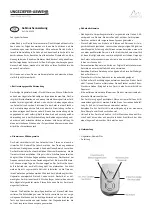
82541PI(ER) and 82562GZ(GX) Dual Footprint LOM Design Guide
Application Note (AP-468)
9
3.1.1.4
Temperature Stability and Environmental Requirements
Temperature stability is a standard measure of how the oscillation frequency varies over the full
operational temperature range (and beyond). Several optional temperature ranges are currently
available, including -40° C to +85° C for industrial environments. Some vendors separate operating
temperatures from temperature stability. Manufacturers may also list temperature stability as 50
ppm in their data sheets.
Note:
Crystals also carry other specifications for storage temperature, shock resistance, and reflow solder
conditions. Crystal vendors should be consulted early in the design cycle to discuss the application
and its environmental requirements.
3.1.1.5
Calibration Mode
The terms “series-resonant” and “parallel-resonant” are often used to describe crystal circuits.
Specifying parallel mode is critical to determining how the crystal frequency is calibrated at the
factory.
A crystal specified and tested as series resonant oscillates without problem in a parallel-resonant
circuit, but the frequency is higher than nominal by several hundred parts per million. The purpose
of adding load capacitors to a crystal circuit is to establish resonance at a frequency higher than the
crystal’s inherent series resonant frequency.
illustrates a simplified schematic of the 82562GZ(GX) and the 82541PI(ER) controller’s
crystal circuit. The crystal and the capacitors form a feedback element for the internal inverting
amplifier. This combination is called parallel-resonant, because it has positive reactance at the
selected frequency. In other words, the crystal behaves like an inductor in a parallel LC circuit.
Figure 1. Crystal Circuit
C1
C2
LAN
Silicon
X1 or Xin
LAN
Silicon
X2 or Xout
















































